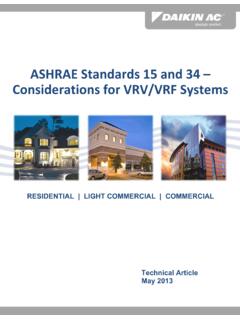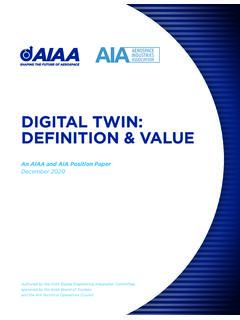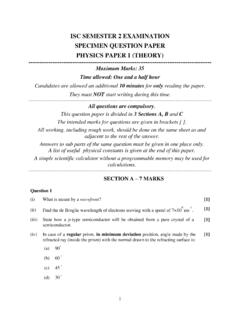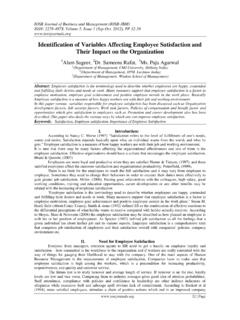Transcription of Correct Resolution of the Twin Paradox - Michael Huemer
1 Correct Resolution of the twin Paradox Michael Huemer In the following, I explain the twin Paradox , which is supposed to be a paradoxical consequence of the Special Theory of Relativity (STR). I give the Correct Resolution of the Paradox , explaining why STR is not inconsistent as it appears at first glance. I also debunk two common, incorrect responses to the Paradox . This should help the reader to understand Special Relativity and to see how the theory is coherent. I. Background: Time and Length Dilation According to STR, different intertial reference frames (RF's) can disagree on the time that elapses between two events, as well as on the length of an object. These discrepancies are described by the Lorentz Transformation equations: Here, L 0 is the length an object has in a reference frame in which it is at rest, while L is the length the object has according to a reference frame in which it is moving at velocity v.
2 Similarly, T 0 is the time between some pair of events in a reference frame in which the events take place at the same (spatial) place, whereas T is the time between those events according to a reference frame in which the events are separated by a path of velocity v (that is, the ratio of the spatial distance between the events to the temporal distance between the events is v). c is the speed of light. For example: suppose I'm in a spaceship that's traveling at c/2 (half the speed of light). relative to the Earth. Suppose that in my reference frame, I measure my ship to be 100 feet long. So L 0 = 100 ft. Then observers on Earth are going to measure my spaceship to have a length of: Similarly, suppose that I have a clock in my spaceship. At the start of my journey, my clock reads 12:00.
3 My clock measures elapsed time according to my reference frame ( , the reference frame 1. in which the spaceship is at rest). So when the clock strikes 1:00, 1 hour has passed in my reference frame. So T 0 = 1 hr. However, people on Earth will see the time between these two events (my clock striking 12:00 and my clock striking 1:00) as being: So people on Earth will perceive my spaceship as having shrunk (since it is 87 feet long, whereas it was 100 feet long when it was at rest), and they will perceive my clock as moving slower than normal (because it takes it 69 minutes, instead of 60 minutes, to register the passage of an hour). II. The twin Paradox . Here's a statement of the twin Paradox , designed to make it seem paradoxical: Suppose that two identical twins start out on Earth, the same age.
4 One of them gets in a spaceship and flies around really fast. Call this one Space twin . The other twin , Earth twin , stays on Earth the whole time. Finally, Space twin comes home and meets up with Earth twin . When they meet, which one will have aged more? Well, according to Earth twin , Space twin was moving around really fast, so Space twin aged slower (like in the example above), so Space twin is going to look younger. But according to Space twin , it was Earth twin who was moving the whole time (in Space twin 's reference frame, Space twin was stationary). So Earth twin was aging slower, so Earth twin is going to look younger. According to STR, both reference frames are equally valid. But presumably, these answers can't both be true; when they see each other, it's not going to be that each of them looks younger than the other.
5 So it looks as if STR with its time dilation postulate is incoherent. The above thinking is in fact wrong; time dilation is not incoherent. I'll explain why below. But first I want to clear the ground of some fallacious explanations. III. Two Wrong Responses to the twin Paradox I have heard two wrong responses (or claims about the response) to the twin Paradox . First, my high school physics teacher said that the Resolution of the twin Paradox had to do with General 2. Relativity, which was beyond the scope of his class. That's false. General Relativity is Einstein's theory of gravitational phenomena. The twin Paradox has nothing to do with gravitation, nor has it anything to do with the spacetime curvature postulated in GR. As we'll see in section IV, the Resolution of the Paradox can be given purely within a flat (Minkowski) spacetime.
6 The second false Resolution I have heard is that it is the Space twin who will have aged slower, because it was he who had to accelerate in order to get up to his great speed. In STR, there is an objective distinction between accelerated and uniform (non-accelerated) motion. So it's an objective fact that Space twin underwent acceleration while Earth twin didn't. Therefore, Space twin is the one who was really going fast, so he'll have aged slower. Now, how many things are wrong with this response? a. The response is profoundly un-relativistic. It supposes that Space twin is the one who was really moving during his voyage, because he's the one who accelerated. (That's like what Newton says about absolute motion.) In relativity theory, there is no objective fact about who is moving at any given point in time; at any time, any given person or object is moving according to som e RF's and stationary according to others, and all inertial RF's are equally legitimate.
7 So the proposed response can't possibly be the Resolution of the problem according to STR. b. There is no requirement, in STR, that there be some initial conditions in which everything starts out at relative rest. Thus, we may stipulate that Space twin does not undergo any acceleration to get up to his great speed instead, suppose that Space twin and Earth twin just start out in relative motion. Space twin is already going at near light speed (relative to Earth) at the start of our story. (Equivalently, Earth twin is already going at near light speed relative to Space twin at the start of the story.). c. There is no mechanism in STR for the past history of some state of motion (or of anything else, for that matter) to directly exert causal power on things now. The Lorentz Transformation Equations discussed in section I above, for example, do not in any way make use of any facts about past history to determine the amount of length or time dilation.
8 Nor does anything in General Relativity do so. Nor, in fact, does any modern physical theory allow the past to directly influence the present (once the current state of the world is given, how we got to that state is irrelevant to what will happen next). So even if Space twin had to undergo acceleration in the past to get to his current speed, that would be irrelevant to what effects his current speed has on him. d. Finally, notice that the Lorentz Equations do not take account of acceleration at all length dilation and time dilation are purely a function of the rest length (L 0) and rest time (T 0), the velocity v, and the speed of light c. Acceleration plays no role. Nor is this different in 3. General Relativity or any other theory (that is, no other theory gives any modified Lorentz transformations where acceleration appears in the equations).
9 Given that, acceleration can't have anything to do with the solution to the Paradox . IV. Correct Resolution of the Paradox . There are two cases to consider: In one scenario, the two twins are in uniform motion throughout the story (they neither accelerate nor decelerate, nor change their direction of motion). In another scenario, Space twin goes off into space for a while, then turns around (deceleration/acceleration) and comes back to Earth. A. The Case of Uniform Motion In the first case, the twins can only have one meeting without accelerating or decelerating, Space twin will never return to Earth, so the meeting in which they finally see who has aged more will never happen. What does STR say about this scenario? It says that each twin will age slower, as measured by the other twin .
10 How can this be? The secret lies in the relativity of simultaneity. Consider the space-time diagram in Figure 1. In this diagram, line t is the time axis, according to Earth twin , while s is the space axis (or: a simultaneity slice) according to Earth twin . Earth twin thinks that he's always stationary, and thus that he remains on the t axis (he does not change his spatial location his position along s as time passes). He thinks that any path parallel to t is the path of a stationary object (that is, any such path is stationary in his reference frame). Also, Earth twin would say that all the spacetime points that lie on s are simultaneous with each other, and all of them occur at (say) t = 0. Earth twin would say that any line parallel to s also marks a collection of spacetime points that are simultaneous with each other.








